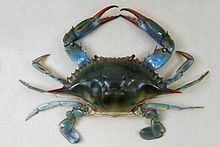Callinectes sapidus
| Callinectes sapidus | |
|---|---|
 |
|
| Scientific classification | |
| Kingdom: | Animalia |
| Phylum: | Arthropoda |
| Subphylum: | Crustacea |
| Class: | Malacostraca |
| Order: | Decapoda |
| Infraorder: | Brachyura |
| Family: | Portunidae |
| Genus: | Callinectes |
| Species: | C. sapidus |
| Binomial name | |
|
Callinectes sapidus Rathbun, 1896 |
|
| Synonyms | |
|
|
| External identifiers for Callinectes sapidus | |
|---|---|
| Encyclopedia of Life | 312939 |
| ITIS | 98696 |
| NCBI | 6763 |
| WoRMS | 107379 |
| Also found in: | |
Callinectes sapidus (from the Greek = "beautiful", nectes = "swimmer", and Latin sapidus = "savory"), the blue crab, Atlantic blue crab, or regionally as the Chesapeake blue crab, is a species of crab native to the waters of the western Atlantic Ocean and the Gulf of Mexico, and introduced internationally.
C. sapidus is of significant culinary and economic importance in the United States, particularly in Louisiana, the Chesapeake Bay, and New Jersey. It is the Maryland state crustacean and is that state's largest commercial fishery.
Callinectes sapidus is a decapod crab of the swimming crab family Portunidae. The genus Callinectes is distinguished from other portunid crabs by the lack of an internal spine on the carpus (the middle segment of the claw), as well as by the T-shape of the male abdomen. Blue crabs may grow to a carapace width of 23 cm (9.1 in). C. sapidus individuals exhibit sexual dimorphism. Males and females are easily distinguished by the shape of the abdomen (known as the "apron") and by color differences in the chelipeds, or claws. The abdomen is long and slender in males, but wide and rounded in mature females. A popular mnemonic is that the male's apron is shaped like the Washington Monument, while the mature female's resembles the dome of the United States Capitol. Claw color differences are more subtle than apron shape. The immovable, fixed finger of the claws in males is blue with red tips, while females have orange coloration with purple tips. A female's abdomen changes as it matures: an immature female has a triangular-shaped abdomen, whereas a mature female's is rounded.
Other species of Callinectes may be easily confused with C. sapidus because of overlapping ranges and similar morphology. One species is the lesser blue crab (C. similis). It is found further offshore than the common blue crab, and has a smoother granulated carapace. Males of the lesser blue crab also have mottled white coloration on the swimming legs, and females have areas of violet coloration on the internal surfaces of the claws.C. sapidus can be distinguished from another related species found within its range, C. ornatus, by number of frontal teeth on the carapace. C. sapidus has four, while C. ornatus has six.
...
Wikipedia
